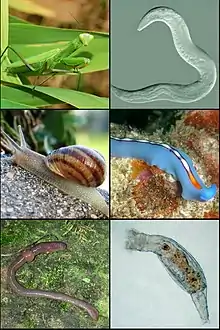Protostome
Protostomia (/ˌproʊtəˈstoʊmi.ə/) is the clade of animals once thought to be characterized by the formation of the organism's mouth before its anus during embryonic development. This nature has since been discovered to be extremely variable among Protostomia's members, although the reverse is typically true of its sister clade, Deuterostomia.[1][2] Well known examples of protostomes are arthropods, molluscs, annelids, flatworms and nematodes. They are also called schizocoelomates since schizocoely typically occurs in them.
| Protostomes Temporal range: | |
|---|---|
 | |
| Some protostomes representing the 6 phyla: Mantis religiosa (Arthropoda), Caenorhabditis elegans (Nematoda), Cornu aspersum (Mollusca), Pseudoceros liparus (Platyhelminthes), Lumbricus terrestris (Annelida), Habrotrocha rosa (Rotifera). | |
| Scientific classification | |
| Kingdom: | Animalia |
| Subkingdom: | Eumetazoa |
| Clade: | ParaHoxozoa |
| Clade: | Bilateria |
| Clade: | Nephrozoa |
| (unranked): | Protostomia Grobben, 1908 |
| Superphyla | |
| |
Together with the Deuterostomia and Xenacoelomorpha, these form the clade Bilateria, animals with bilateral symmetry, anteroposterior axis and three germ layers.[3]
Protostomy

In animals at least as complex as earthworms, the first phase in gut development involves the embryo forming a dent on one side (the blastopore) which deepens to become its digestive tube (the archenteron). In the sister-clade, the deuterostomes (lit. 'second-mouth'), the original dent becomes the anus while the gut eventually tunnels through to make another opening, which forms the mouth. The protostomes (from Greek πρωτο- prōto- 'first' + στόμα stóma 'mouth') were so named because it was once believed that in all cases the embryological dent formed the mouth while the anus was formed later, at the opening made by the other end of the gut.[4][1] It is now known that the fate of the blastopore among protostomes is extremely variable; while the evolutionary distinction between deuterostomes and protostomes remains valid, the descriptive accuracy of the name protostome is disputable.[1]
Protostome and deuterostome embryos differ in several other ways. Many protostomes (the Spiralia clade) undergo spiral cleavage during cell division instead of radial cleavage.[5] Spiral cleavage happens because the cells' division planes are angled to the polar major axis, instead of being parallel or perpendicular to it. Another difference is that secondary body cavities (coeloms) generally form by schizocoely, where the coelom forms out of a solid mass of embryonic tissue splitting away from the rest, instead of by enterocoelic pouching, where the coelom would otherwise form out of in-folded gut walls.[6]
Evolution
The common ancestor of protostomes and deuterostomes was evidently a worm-like aquatic animal of the Ediacaran. The two clades diverged about 600 million years ago. Protostomes evolved into over a million species alive today, compared to about 60,000 deuterostome species.[7]
Protostomes are divided into the Ecdysozoa (e.g. arthropods, nematodes) and the Spiralia (e.g. molluscs, annelids, platyhelminths, and rotifers). A modern consensus phylogenetic tree for the protostomes is shown below.[8][9][10][11][12] The timing of clades radiating into newer clades is given in mya (millions of years ago); less certain placements are indicated with dashed lines.[13]
| Bilateria |
| |||||||||||||||||||||||||||||||||||||||||||||||||||||||||||||||||||||||||||||||||||||||||||||
See also
- Embryological origins of the mouth and anus
- The Taxonomicon for Karl Grobben
References
- Hejnol, A.; Martindale, M. Q. (2009). "The mouth, the anus, and the blastopore - open questions about questionable openings". In M. J. Telford; D. T. J. Littlewood (eds.). Animal Evolution — Genomes, Fossils, and Trees. pp. 33–40.
- Martín-Durán, José M.; Passamaneck, Yale J.; Martindale, Mark Q.; Hejnol, Andreas (2016). "The developmental basis for the recurrent evolution of deuterostomy and protostomy". Nature Ecology & Evolution. 1 (1): 0005. doi:10.1038/s41559-016-0005. PMID 28812551. S2CID 90795.
- Hejnol, A.; Obst, M.; Stamatakis, A.; Ott, M.; Rouse, G. W.; Edgecombe, G. D.; et al. (2009). "Assessing the root of bilaterian animals with scalable phylogenomic methods". Proceedings of the Royal Society B: Biological Sciences. 276 (1677): 4261–4270. doi:10.1098/rspb.2009.0896. PMC 2817096. PMID 19759036.
- Peters, Kenneth E.; Walters, Clifford C.; Moldowan, J. Michael (2005). The Biomarker Guide: Biomarkers and isotopes in petroleum systems and Earth history. Vol. 2. Cambridge University Press. p. 717. ISBN 978-0-521-83762-0.
- Valentine, James W. (July 1997). "Cleavage patterns and the topology of the metazoan tree of life". PNAS. The National Academy of Sciences. 94 (15): 8001–8005. Bibcode:1997PNAS...94.8001V. doi:10.1073/pnas.94.15.8001. PMC 21545. PMID 9223303.
- Safra, Jacob E. (2003). The New Encyclopædia Britannica, Volume 1; Volume 3. Encyclopædia Britannica. p. 767. ISBN 978-0-85229-961-6.
- Dawkins, Richard. The ancestor’s tale. Boston. Mariner Books. 2004. p. 377–386
- Edgecombe, Gregory D.; Giribet, Gonzalo; Dunn, Casey W.; Hejnol, Andreas; Kristensen, Reinhardt M.; Neves, Ricardo C.; Rouse, Greg W.; Worsaae, Katrine; Sørensen, Martin V. (June 2011). "Higher-level metazoan relationships: recent progress and remaining questions". Organisms, Diversity & Evolution. 11 (2): 151–172. doi:10.1007/s13127-011-0044-4. S2CID 32169826.
- Fröbius, Andreas C.; Funch, Peter (2017-04-04). "Rotiferan Hox genes give new insights into the evolution of metazoan bodyplans". Nature Communications. 8 (1): 9. Bibcode:2017NatCo...8....9F. doi:10.1038/s41467-017-00020-w. PMC 5431905. PMID 28377584.
- Smith, Martin R.; Ortega-Hernández, Javier (2014). "Hallucigenia's onychophoran-like claws and the case for Tactopoda" (PDF). Nature. 514 (7522): 363–366. Bibcode:2014Natur.514..363S. doi:10.1038/nature13576. PMID 25132546. S2CID 205239797.
- "Palaeos Metazoa: Ecdysozoa". palaeos.com. Retrieved 2017-09-02.
- Yamasaki, Hiroshi; Fujimoto, Shinta; Miyazaki, Katsumi (June 2015). "Phylogenetic position of Loricifera inferred from nearly complete 18S and 28S rRNA gene sequences". Zoological Letters. 1: 18. doi:10.1186/s40851-015-0017-0. PMC 4657359. PMID 26605063.
- Peterson, Kevin J.; Cotton, James A.; Gehling, James G.; Pisani, Davide (2008-04-27). "The Ediacaran emergence of bilaterians: congruence between the genetic and the geological fossil records". Philosophical Transactions of the Royal Society of London B: Biological Sciences. 363 (1496): 1435–1443. doi:10.1098/rstb.2007.2233. PMC 2614224. PMID 18192191.
External links
 Media related to Protostomia at Wikimedia Commons
Media related to Protostomia at Wikimedia Commons


.jpg.webp)